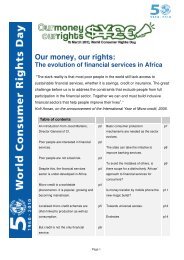Voices for Change: the Consumer Right to Representation
Voices for Change: the Consumer Right to Representation
Voices for Change: the Consumer Right to Representation
You also want an ePaper? Increase the reach of your titles
YUMPU automatically turns print PDFs into web optimized ePapers that Google loves.
World <strong>Consumer</strong> <strong>Right</strong>s Day 2002: <strong>Voices</strong> <strong>for</strong> <strong>Change</strong><br />
5 The State of <strong>Representation</strong><br />
Results of a survey on representation<br />
conducted among CI members bring no big<br />
surprises and at least one encouraging<br />
finding. Despite <strong>the</strong> fact that specific<br />
ratings of “excellent” impacts are relatively<br />
few, respondents view <strong>the</strong> overall impact of<br />
consumer representation as more positive<br />
than negative. This overview is based on<br />
responses <strong>to</strong> a questionnaire distributed <strong>to</strong><br />
CI members and analysed by <strong>the</strong> UK’s<br />
National <strong>Consumer</strong> Council <strong>for</strong> CI.<br />
Designed specifically <strong>for</strong> World <strong>Consumer</strong>s<br />
<strong>Right</strong>s Day 2002, <strong>the</strong> survey paints an<br />
interesting picture of consumer representation<br />
around <strong>the</strong> globe. Nearly 70 CI member<br />
groups responded <strong>to</strong> a questionnaire in which<br />
<strong>the</strong>y were asked <strong>to</strong> describe and rank various<br />
categories and impacts of <strong>the</strong>ir activities in<br />
consumer representation. Respondents were<br />
also invited <strong>to</strong> submit case studies of notable<br />
impact and/or need. Quantitative analysis of<br />
<strong>the</strong> responses was conducted by Adam Smith<br />
at <strong>the</strong> UK’s National <strong>Consumer</strong> Council and is<br />
summarised here. Selected case studies are<br />
included in Annexes B and C, with a copy of<br />
<strong>the</strong> sample questionnaire in Annex D.<br />
Fifty-four responses were received in time <strong>for</strong><br />
<strong>the</strong> survey analysis: five from Asia/Pacific;<br />
nine from Africa; 17 from Latin America and<br />
<strong>the</strong> Caribbean; 23 from Europe. The combined<br />
data are significantly skewed by <strong>the</strong> data from<br />
Europe and Latin America, due <strong>to</strong> <strong>the</strong> high<br />
response rates from <strong>the</strong>se regions.<br />
The principal overall conclusion <strong>to</strong> be<br />
drawn from <strong>the</strong> survey is that consumer<br />
representation is strongest in <strong>the</strong> sec<strong>to</strong>rs of<br />
consumer policy and protection, justice/<br />
redress, environment, health, food security,<br />
food safety, technical standards and utilities.<br />
This is unsurprising, given that <strong>the</strong>se are <strong>the</strong><br />
most obvious and traditional areas <strong>for</strong><br />
consumer advocacy.<br />
The survey relays <strong>the</strong> encouraging news that<br />
most respondents view <strong>the</strong> impact of<br />
consumer representation as more positive than<br />
negative. This is especially true <strong>for</strong> <strong>the</strong> issues<br />
of consumer policy and protection,<br />
justice/redress, sustainable consumption/<br />
environment, food safety and technical<br />
standards and utilities – issues where<br />
consumer representation is most consolidated.<br />
Transport is <strong>the</strong> only example in which<br />
negative responses predominate. Only <strong>the</strong><br />
smallest minority of responses see consumer<br />
representation as being “very poor” across<br />
all areas covered in <strong>the</strong> survey.<br />
Levels of representation taper off <strong>for</strong><br />
competition, trade/economics, education,<br />
communication and in<strong>for</strong>mation technology,<br />
social issues/poverty alleviation, price<br />
controls, gender/women, financial services<br />
regulation and transport.<br />
In <strong>the</strong> majority of cases where representation<br />
occurs, it is <strong>the</strong> responding organisation that<br />
represents consumers. In some cases, this role<br />
is carried out in conjunction with o<strong>the</strong>r<br />
organisations. The data from each region was<br />
fairly consistent with <strong>the</strong> overall data, with <strong>the</strong><br />
following exception: in Africa, <strong>the</strong>re is a<br />
relatively low level of representation in<br />
justice/redress, and a high level of<br />
representation in social issues/poverty<br />
alleviation.<br />
29






![pkef]Qmf eg]sf] s] xf] < - Consumers International](https://img.yumpu.com/6479658/1/184x260/pkefqmf-egsf-s-xf-consumers-international.jpg?quality=85)
